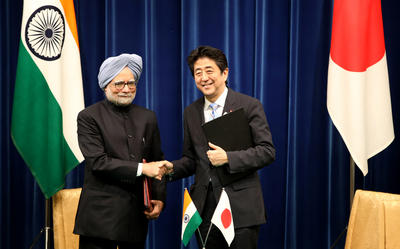The visit assumes significance at a time when the world is slowly coming out of financial crisis and the macroeconomic foundations of both countries are being tested.
India and Japan have historically been friends, right from Japan’s Meiji era through episodes in modern history up until today. The relationship has been underpinned by not just commerce but also a sense of like-mindedness with regards to world politics. Ties between the two got a further boost during the post-Cold War period when Japan was faced with a rising China and a hostile North Korea, and India liberalised its economy and embraced globalisation. Since 1958, when economic cooperation between Japan and India formally began, India has received substantial Japanese overseas development assistance, but the ties aren’t limited to aid or assistance.
As it stands today, there is both untapped potential for cooperation as well as scope for strengthening existing ties. Economic engagement should be at the heart of a 21st-century Indo-Japanese relationship. Of course strategic and geopolitical cooperation at the global high tables should continue too and be a major pillar of this growing bilateralism.
Already the two countries work together in the area of UN reforms. On the strategic side of things, Japan’s economic cooperation with India is also a hedge against a rising China, which is a challenge for Japan as also India, if to a lesser extent. Increased India-Japan bilateral cooperation also fits into India’s foreign policy approach of looking eastwards. Additionally, the trilateral talks between the US, India and Japan, as well as the bilateral India-Japan relationship, helps counterbalance Chinese assertiveness in the region.
The Comprehensive Economic Partnership Agreement (CEPA) signed between India and Japan in 2011 has cemented ties between the two and given a clear signal to the world about the seriousness of the relationship. Under the CEPA, tariffs have been slashed on more than 8000 products, including apparel, agricultural products and machinery, and also cover services, labour and investments.
With the CEPA coming into effect in August 2011, it is too early to confirm its impact. But over the first year of its operation, India’s exports went up by 24 per cent while it imported 40 per cent more from Japan. The estimated trade volume for 2014 is US$25 billion, a rise from US$18.3 billion in 2013. As the figures demonstrate, India’s trade deficit with Japan grew to somewhat uncomfortable levels following the CEPA and Japan seemed to benefit more. Of course, India is yet to realise the full benefits because as per the agreement Japan will eliminate tariffs on 97 per cent of the items over a period of 10 years.
Japanese firms’ interest in India is no new thing. Sony and Suzuki have long been well-known brand names in Indian households. Indo-Japanese cooperation in electronics received a boost in recent times when Japanese firms started to look beyond China, even as it deals with a huge loss in market share to South Korean and Taiwanese firms. But Japanese technology remains dear to India, and India’s market size and rising demand for consumer durables continues to attract Japanese firms, many of which in 2013 announced massive investments in India.
What has been particularly heartening is Japan’s assistance in India’s infrastructure. It is no secret that India needs to pump in heavy investments to beef up its crumbling infrastructure. The government has articulated the need for US$1 trillion in investments. Japan has strongly chipped into this effort and its cooperation reflects the growing responsiveness of Japan to India’s needs. There are gains for Japan too, as Japanese firms are entering into profitable joint ventures with Indian companies. And with Japan’s capacity to invest in capital-intensive long-gestation projects, it might be just what the doctor ordered for India.
Buoyed by the incredible success of the Delhi Metro, which was largely funded by low-cost loans from the Japan International Cooperation Agency (JICA), the Chennai Metro Project too is funded by Japan and is a potential shining example of Indo-Japanese cooperation. That the thrust of JICA’s activities is on India is borne out by the fact that over 50 per cent of the value of all JICA projects in South Asia are cornered by India. The projects are all in strategic sectors that offer Japanese companies strong business opportunities. It’s a win-win partnership that one hopes will be further fortified by Abe’s visit this Republic Day.
Geethanjali Nataraj and Abhirup Bhunia are researchers at the Observer Research Foundation, New Delhi.
An earlier version of this article was first published here in The Financial Express.

